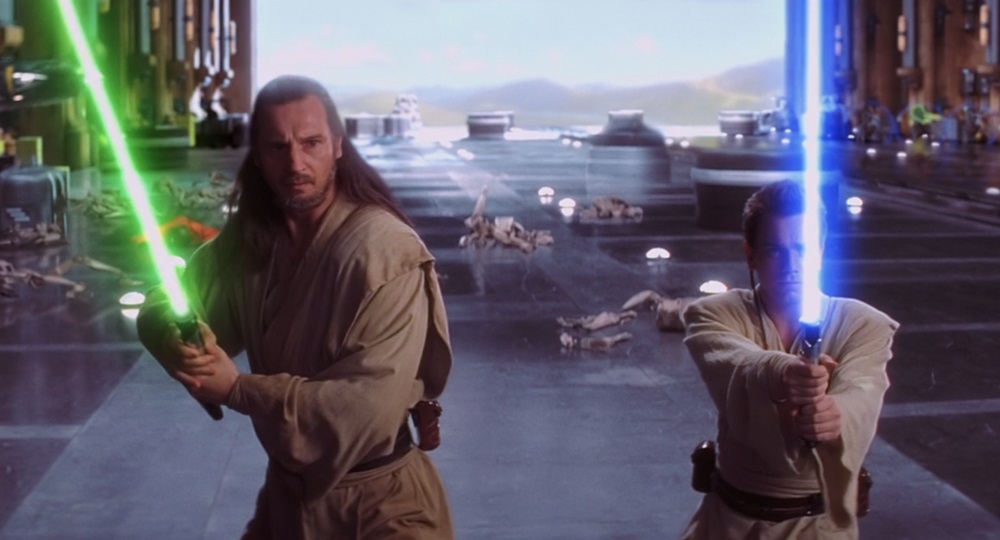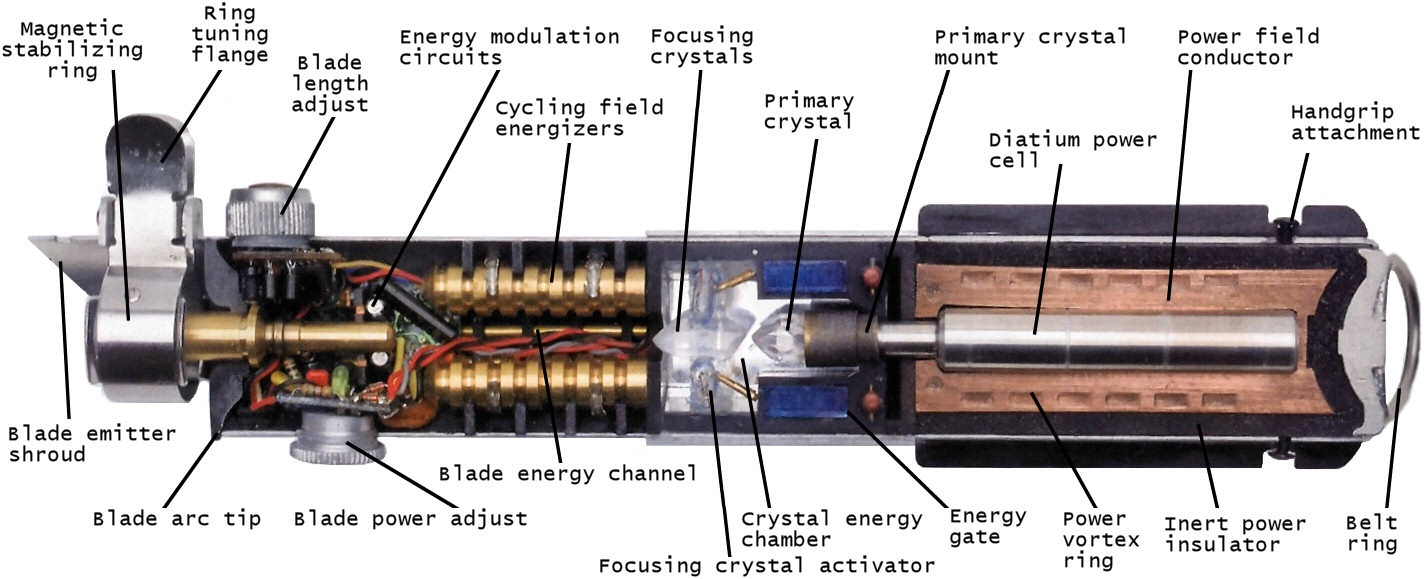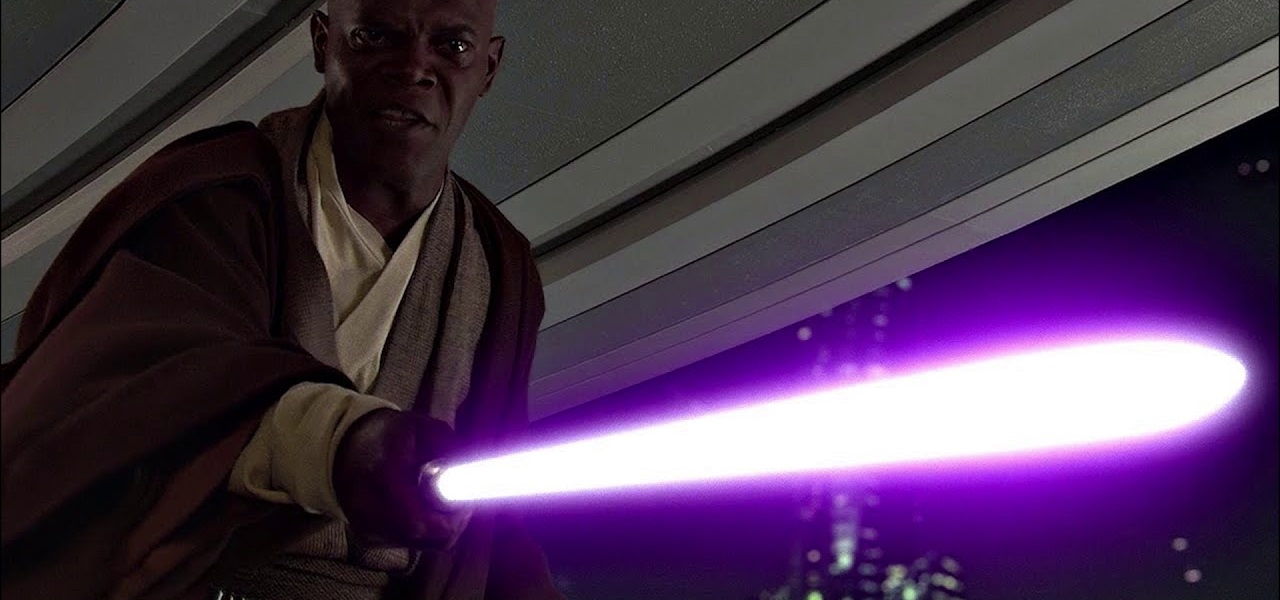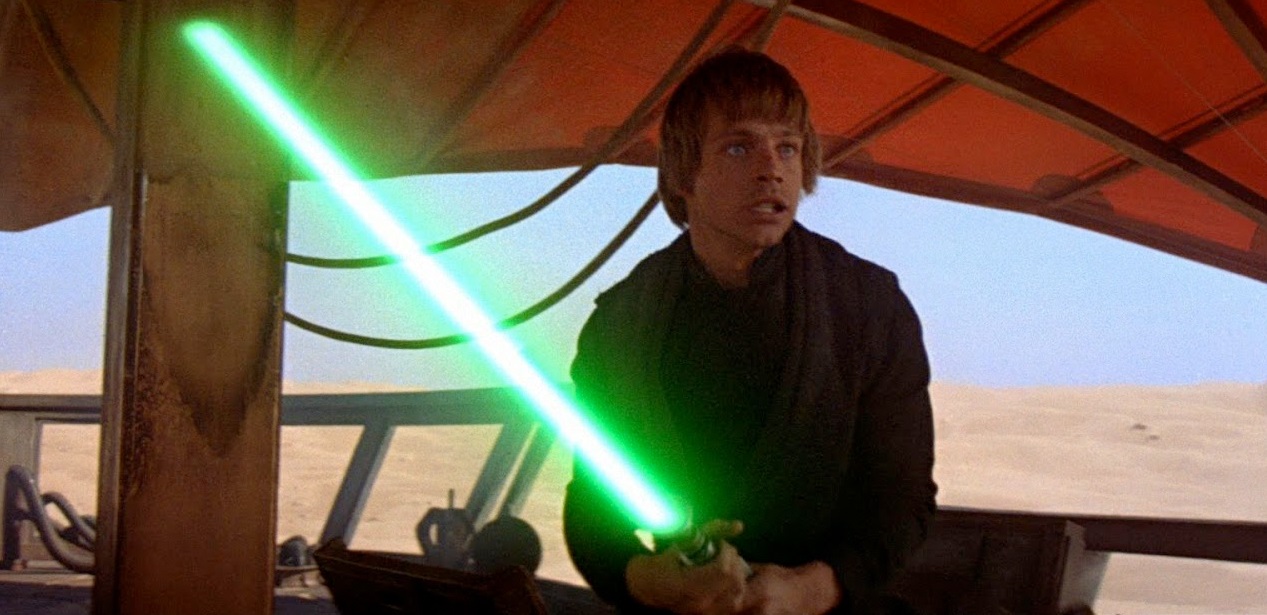

The Jedi | The Sith | Other Force Religions | Lightsabers
Lightsabers

Lightsabers, "the weapon of a Jedi Knight", are ancient plasma-blade weapons energized by kyber crystals, which amplify the Force.
Usually referred to as "laser swords" by George Lucas in the 70s and during the production of the original trilogy, lightsabers were first
introduced by Obi-Wan, who called them "an elegant weapon for a more civilized age." As Lucas explains, "In developing a group of
peacekeepers, I needed a weapon that was appropriate. It was more a symbol of a simpler time, of a time before the Empire had taken
over - a time when honor ruled." The Jedi are a composite of a number of influences, however their use of lightsabers most directly
connects to the samurai and martial traditions of Japanese swordsmanship. These weapons cannot be safely or effectively used by
those without training, and thus like the katana or the superior steel of western knights, the ability to wield one is a sign of great martial
prowess, and they are an icon of the power of those who wield them. Lucas established that these weapons were considered archaic
in the face of modern blasters and other weapons, while the Jedi considered such weapons to be "uncivilized." The Jedi and Sith
ability to use the Force makes the lightsaber in their hands far more powerful than a blaster, both offensively and as a shield against
energy weapons. The degree to which a Jedi's power is enhanced by a lightsaber leads the Jedi to teach their students that "this
weapon is your life." Unlike a blaster, a lightsaber can often be used to defeat an enemy without injury or killing, which the Jedi value.

Lightsabers are heavier than one might expect for an object of their size, and become even heavier when activated. They become
light and easy to wield when a connection is formed through the Force. "Energy constantly flows through the crystal", and a saber
wielder is "not fighting with a simple blade as much as you are directing a current of power." Lightsabers are capable of cutting
through nearly all materials, both natural and artificial, with some exceptions. Some materials which were very strong would slow
a lightsaber's cutting speed, but most metals offered no meaningful resistance to a saber's blade. Some of the strongest materials
were lightsaber-resistant, however could still be cut with prolonged contact. The famous Beskar steel of the Mandalorians and
at least one other alloy called Phrik were strong enough to maintain cohesion against a lightsaber. Lightsabers were best opposed
by energized melee weapons, force fields, other sufficiently powerful energy-based defenses, and of course, other lightsabers.
Lightsabers can be turned on or used by any living being, since an energy in the Force is required to operate them, however once
active they are heavy and difficult to wield by those who cannot form a direct connection with them through the Force. They are
very dangerous to operate without the precognition offered by a strong connection to the Force, however some warriors of great
skill and ability who cannot wield the Force are able to use a lightsaber. These warriors are rarely a threat to a Jedi or Sith, with some
notable exceptions. This is because a Jedi's natural power with the Force is united with the power of the kyber crystal in the lightsaber,
making the saber an extension of their body and of their will in the Force. In a sense, a Jedi is like an organic version of a lightsaber,
wielded by the Force to impose its will, with a Jedi's heart acting as their crystal which is sensitive to the Force. "The crystal is the heart
of the blade. The heart is the crystal of the Jedi. The Jedi is the crystal of the Force. The Force is the blade of the heart. All are
intertwined: the crystal, the blade, the Jedi. You are one." When wielding a lightsaber, "your thoughts, your actions, they become
energy. They flow through the crystal as well, and become a part of the blade." As a result, lightsabers will deactivate once dropped
due to the loss of their connection to the one who was wielding them, which is an important feature which prevents the lightsaber
from continuously slicing through material, or injuring a wielder who is unexpectedly hurled about. A lightsaber can remain active
when thrown by someone with intention, however it will soon turn off if a connection is not maintained in the Force.
LIGHTSABER CONSTRUCTION
Lightsabers are very rare, primarily because one needs to use the Force to construct them. A Force wielder must first understand
the saber's design, gather the parts including the kyber crystal, and then assemble the saber by connecting to the components with
the Force. A lightsaber which has been physically assembled without this process will not work, or will explode due to overload.
The kyber crystal within must not only be correctly oriented, it must also be aligned in the Force with the flow of energy from its
power cell, which can only be achieved by the direct connection in the Force from the one constructing it. Ahsoka explains,
"You must trust that the components that form your lightsaber are meant to be together. There is no other way. It is the Force
that binds them." Construction of a saber is the last of the basic Jedi skills, and indicates that a student has become powerful
and knowledgeable enough with the Force to eventually become a Jedi Knight.



Despite the common assertion that the kyber crystals "power the Jedi's lightsabers", the actual power source is a diatium power
cell, or similarly compact power source with sufficient strength. The kyber crystals channel this power and draw additional energy
from the Force, thus creating a stable blade in the form of a plasma loop which cycles back through the lightsaber assembly. This
energy is moderated internally by an energy field of some kind, which keeps the lightsaber from heating up or exploding due to
the continuous cycling of energy. Controls on most lightsabers allow the user to adjust the blade length and intensity.

LIGHTSABER CRYSTALS
The heart of a lightsaber is a Force-sensitive crystal, almost always a kyber crystal, which grow naturally in abundance on a very limited
number of planets in the galaxy. These planets were often important to the Jedi, and some were closely guarded, especially the planet
Ilum where the Jedi maintained a temple over significant deposits of kyber. These crystals 'sing' due to their continually amplifying
energy from the Force. When seeking a lightsaber crystal, a Jedi will listen for the crystal which calls to them in the Force. All kyber
crystals are white in nature, but take on one of five colors in response to how they first interact with the Force through living things,
which generate the Force. Once colorized by a living being's Force energy, crystals tend to retain their color, except in very rare
situations. According to supplementary and non-canon material, red crystals do not occur in nature, and must be artificially forced
to turn red using the dark side of the Force, which is why only dark side practitioners are ever seen with them. Force wielders may
use a saber of any color, however due to the personal nature of a lightsaber, most prefer using a crystal which resonates as they do.
White
White light is the full spectrum of kyber crystals. All kyber crystals are naturally white, but only remain white if they do not take on
a color when a Force wielder collects them. A Force wielder can also induce an artificially red crystal to return to white using
the light side of the Force. It is unknown if this can be done to a naturally colored crystal. White represents the holistic Force
in all its vibrations, and therefore also its true nature - the Ashla (light side). Attributes connected to white include purity, clarity,
charity, sincerity, calm, patience, humility, and selflessness. White sabers are less common in the 'modern' era of films and shows,
and are usually associated with Jedi Consulars.

Purple
Purple light is a natural spectrum of kyber crystals. Purple represents the cosmic Force, the highest vibration of the Force, and thus
also represents unity, energy, will, and essence. Attributes connected to purple include strength, morality, creativity, vision, and parity.
Purple sabers are less common in the 'modern' era of films and shows, and are usually associated with Jedi Guardians.

Blue
Blue light is a natural spectrum of kyber crystals. Blue represents awareness of the Force, and the ability to use it, in particular,
the Ashla (light side) of the Force. It represents the balance between the cosmic Force and the living Force, and thus also
the individual, the body, and the physical. Attributes connected to blue include altruism, justice, truth, good, purpose, defence,
actualization, ability, artistry, and skill. Blue sabers are very common in all eras, and are usually associated with Jedi Guardians.

Green
Green light is a natural spectrum of kyber crystals. Green represents the living Force. It represents the balance between the Ashla
(light side) and the Bendu (balance) of the Force. It also represents balance between ability and stability, and thus also life, spirit,
peace, virility, and nature. Attributes connected to green include harmony, respect, mediation, esteem, achievement, and confidence.
Green sabers are very common in all eras, and are usually associated with Jedi Consulars.

Yellow
Yellow light is a natural spectrum of kyber crystals. Yellow represents the Bendu (balance) of the Force. It also represents balance
between the living Force and the mind, and thus also stability, wisdom, health, and equality. Attributes connected to yellow include
moderation, devotion, belonging, fraternity, and guardianship. Yellow sabers are somewhat common in the 'modern' era of films
and shows. They are usually associated with Jedi Sentinels, and Jedi Temple Guards in particular.

Orange
Orange light is a natural spectrum of kyber crystals. Orange, the lowest natural vibration of kyber crystals, represents the mind.
It represents the balance between the Bendu (balance) of the Force and the Bogan (dark side), and thus also knowledge,
insight, and mentality. Attributes connected to orange include ingenuity, ambiguity, adaptability, negotiation, and inventiveness.
Orange sabers are rare in the 'modern' era of films and shows, and were historically associated with Jedi Sentinels.
They were also used historically and in the 'modern' era by Dark Jedi.


Red
Red light is an artificial spectrum of kyber crystals, which must be induced by a Force wielder using the dark side.
Red, the lowest possible vibration of a kyber crystal, represents the Bogan (dark side), the lowest vibration
of the Force. It also represents the absolute self, the material, the artificial, and the unnatural. Attributes connected
to red include selfishness, passion, absolutism, power, aggression, hate, evil, deception, and greed. Red sabers are
common in all eras, and are always associated with the Sith, Dark Jedi, or other dark side Force wielders.

Black
Black sabers are artificial and extremely rare. It is unclear if they are powered by kyber crystals, which seems
unlikely. Black represents the lack of vibration in the Force, and thus represents death, but also the self and
form. Attributes connected to black include constancy, excellence, elegance, disparity, and self-obsession.
The only known black saber is the Darksaber, a unique weapon associated with the Mandalorian clan Vizsla,
and its creator, Jedi Knight Tarre Vizsla.

LIGHTSABER COMBAT
In combat, lightsabers are effective as both as a melee weapon for attack and as a shield against blaster fire or energized melee weapons.
Using them selectively for either purpose requires at least a basic mastery of the Force, and in many instances, significant training in
martial arts including swordsmanship. In developing lightsaber combat against opponents with lightsabers, Lucas combined the forms
of kendo and kenjutsu with the traditional dueling and swordfighting techniques of medieval Europe. The Jedi and Sith primarily use
seven fighting forms applied in various ways to an individual's fighting style, however few styles relied exclusively on a single form.
When combatants duel with lightsabers, the blades are drawn to each other, and can also withstand the direct energy of each other.
This makes lightsaber dueling in some ways a unique art which is not totally comparable to any traditional swordfighting approach.

Form I - Shii-Cho
The Determination Form is the direct offensive form developed from traditional swordfighting forms, modified for the abilities
of lightsabers and the Jedi preference to disarm rather than destroy. After each move the saber is returned to a defensive posture.
Form I often seems aggressive, but requires calm and is ultimately defensive, seeking to force conflict and resolve it directly and definitively.

Form II - Makashi
The Contention Form is the elegant dueling form, developed for facing single opponents with lightsabers or other melee weapons.
Form II is based on balanced footwork advancing and retreating on a line, utilizing precise attacks and carefully controlled strikes.

Form III - Soresu
The Resilience Form is the defensive form, developed to counter the rise of blaster technology, but also useful against melee weapons.
Form III is designed to deflect blaster bolts, and uses moving predictive meditation to take on complex battle situations defensively.
This almost entirely defensive form can be applied to lightsaber and other melee combat, making the lightsaber a versatile shield against most weapons.

Form IV - Ataru
The Aggression Form is the acrobatic offensive form, developed to take advantage of the speed and physical abilities made possible by using the Force.
Form IV is characterized by rapid movement of the lightsaber, non-linear and acrobatic moves, and multi-directional attacks. It is best used in open areas.
This almost entirely offensive form can be applied to lightsaber and other melee combat, incorporating defensive moves and blaster deflection.

Form V - Shien & Djem So
The Perseverance Form is the power form, developed to maximize counterattack and channel strength.
Form V has two disciplines. Shien uses the Force to reflect blaster bolts at targets, even back to its source, turning the attack into a counterattack.
Djem So applies this to lightsaber and melee combat, parrying attacks and reflecting them with broad, powerful counters, or channeling strength
into armor. This form combines the strengths of Form III and Form IV, but the power required to use this form requires focus and concentration.

Form VI - Niman
The Moderation Form is the balanced form, developed to take advantage of the strengths of the first five forms.
Form VI combines elements of the other forms to create a practical, adaptable, and defensively focused form that was capable of a strong counterattack.
This form was developed by Jedi seeking a powerful form that emphasizes balance and harmony, but was also utilized by the Sith for its versatility.

Form VII - Juyo & Vaapad
The Ferocity Form is the aggressively unpredictable form, developed to advantage powerful wielders capable of using it.
Form VII has two disciplines. Juyo increases power by channeling aggression, anger, or passion, and employs a disorganized or chaotic fighting style.
Vaapad is an alternative discipline of this form developed by the Jedi to safely channel negative emotion into constructive purpose. Only powerful
Jedi Masters can use this form, due to the powers required, and the advanced training needed to use it safely without tending towards the dark side.

Jar'Kai Style
Jar'Kai is a style using a series of forms, developed for wielding two lightsabers or dual-blade lightsabers. Relying heavily on Form IV, Ataru,
this style encourages a variety of moves and approaches to account for the advantages and drawbacks of two blades. This style also employed
many of the principles of Form VI, Niman, as managing the two blades effectively requires a balanced approach. Elements of most of
the other forms can be successfully adapted to Jar'Kai fighting styles, allowing for a wide range of potential attacks and defenses.

FURTHER ANALYSIS
All 7 Lightsaber Fighting Styles Explained (In Depth)